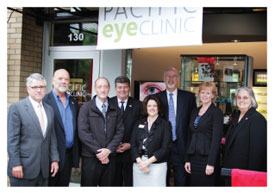Amid growing recognition by eyecare professionals of the importance of 3D vision in entertainment, arts, sports, medicine and other fields, Pacific University has opened a facility near its campus here dedicated to diagnosing and treating eye coordination problems that affect 3D vision. The facility, known as the 3D Performance Eye Clinic, held a grand opening celebration on Oct. 6.
 A full-service eyecare center housed within EyeClinic Beaverton, the 3D Performance Eye Clinic employs state-of-the-art technology, including a movie theater for one, to measure binocular vision performance.
A full-service eyecare center housed within EyeClinic Beaverton, the 3D Performance Eye Clinic employs state-of-the-art technology, including a movie theater for one, to measure binocular vision performance.
“The 3D Performance Eye Clinic is the first-ever clinic that specializes in diagnosing and managing the eye and health-related symptoms related to viewing 3D electronic displays,” says Jim Sheedy, OD, director of Pacific’s Vision Performance Institute (VPI), a research arm of the College of Optometry.
Representatives from the American Optometric Association, THX, Intel and Pacific University’s College of Optometry were on hand for the grand opening. Pictured from left to right are AOA associate director for health sciences and policy, Michael Duenas, OD; THX Director of Education John Dahl; Intel director of user experience Philip Corriveau; THX senior vice president and 3D@Home Consortium chair Rick Dean; Pacific University Optometry dean Jennifer Smythe; Pacific Vision Performance Institute director Jim Sheedy, OD; AOA president Dori Carlson, OD; and Pacific University president Lesley Hallick.
TRANSITIONS OPTICAL INTRODUCES NEW MULTICULTURAL CONSUMER COURSE
Transitions Optical is introducing a new continuing education course providing insights into the “New Multicultural Consumer.” The 50-minute seminar, approved by the American Board of Opticianry, shares current research on spending mindsets and habits, changing media patterns, demographic shifts, the continued impact of acculturation and assimilation, and specific eyecare and eyewear perceptions for each of the three largest and fastest-growing demographic groups. Strategies for attracting and retaining culturally diverse patients are included. The course can be downloaded through the Education section of transitions.com/pro, and will soon be available to take for credit online at transitions.com/education.
“Today’s multicultural consumer has a new mindset, influenced by the economy and by shifting cultural and societal trends—meaning eyecare professionals may need to adapt the way they communicate with their culturally diverse patients in order to best serve them,” says Manuel Solis, multicultural marketing manager, Transitions Optical. “This course gives eyecare professionals a firsthand look at the needs and wants of today’s multicultural consumer, and provides an understanding of the key factors that are driving their patients to make eyecare and eyewear purchasing decisions.”
The course, which is supplemented by new consumer research from Transitions Optical, provides an overview on the common consumer profiles for today’s Hispanic, African-American and Asian-American patients, taking into consideration unique cultural values and potential barriers to care. The course also explores reasons why culturally diverse patients are not scheduling eye exams, and what they look for when selecting an eyecare professional or making an eyewear purchase.
For additional information about the multicultural education and resources available from Transitions Optical, or to express interest in presenting this course, contact [email protected] or call Transitions Customer Service at (800) 848-1506.
—Andrew Karp











